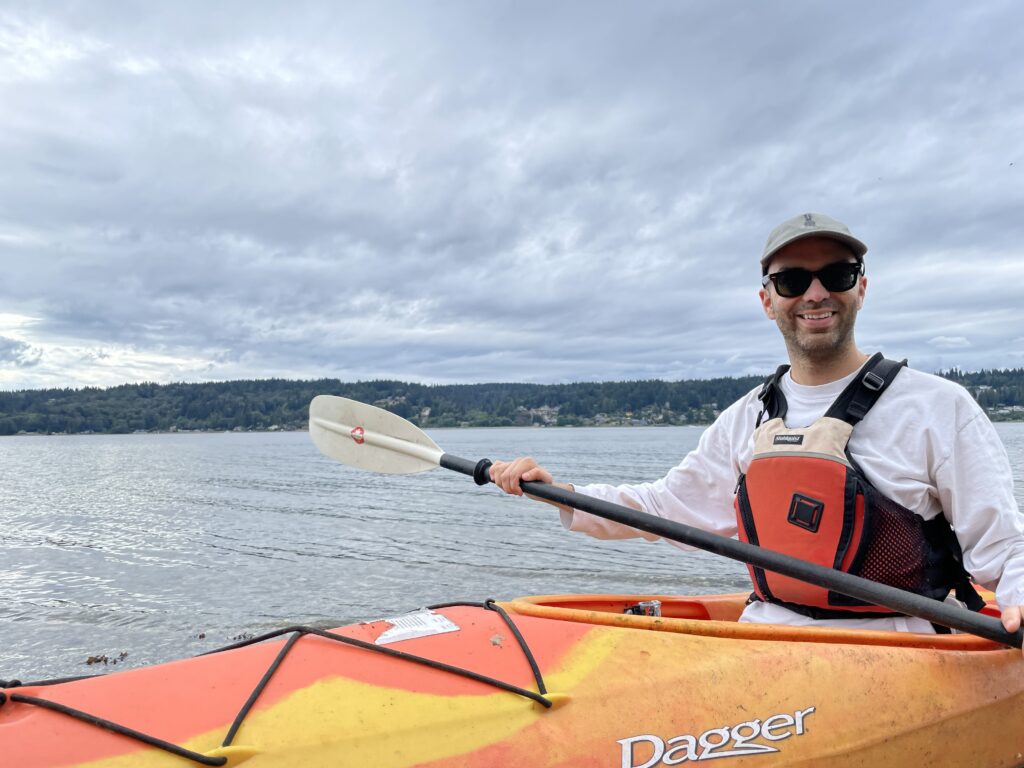The Power of Story: Historian Sean Fraga joins Environmental Studies faculty
Growing up on Washington’s Bainbridge Island, just off the coast of Seattle, Sean Fraga spent many of his waking hours immersed in the region’s unique and stunning natural environment. The tall fir and pine trees and landscapes shaped by tides were his playground–but he took it all for granted, he says, until he went to college. There, he experienced an academic awakening that turned his mind back to the landscapes of his childhood and shaped the research he’ll bring to his new role as an assistant professor (teaching) in the USC Dornsife Environmental Studies Program (ENST).
Fraga enrolled for undergraduate studies at Yale University planning to study the Middle East, learn Arabic, and enter the U.S. Foreign Service. Then a history class changed his mind. “I realized that not only could I study the past, but it was also a window into the present,” he says. He remembered his childhood kayaking excursions around the derelict wharves and pilings of Bainbridge Island, and he began to wonder about the stories behind them.

“They’re still there like ghosts in the landscape, a reminder of a different way of organizing the environment and interacting with the world,” he says. “I realized that I could learn more about the place I was from, that it had a unique history in the U.S.”
Digging into Yale’s archives on the North American West and then continuing to a history Ph.D. at Princeton, Fraga also discovered that his relationship to Seattle was unusual. Growing up, he nearly always approached the city by ferry, and he always thought of Seattle in the context of its relationship to the ocean. He didn’t see that way of understanding the North American West–as a coastal region, with the ocean as central to its history–well-represented in academic literature. Instead, scholars tended to focus on terrestrial stories: the Gold Rush, farming, cattle ranching. And research on water almost always focused on inland water sources, scarcity, and drought.
As Fraga points out, however, the Pacific coastline is the U.S.’s longest international border. Water has shaped the West Coast landscape and the way people conceive of using it. For instance, he says, many explorers and settlers who traveled West overland did so with a motivation to see the fabled Pacific Ocean. The search for the Northwest Passage, a more efficient way to move trade goods to the Pacific Ocean, drove centuries of European explorers and colonizers, starting with Christopher Columbus. And even though we typically think of the transcontinental railroad as enabling travel between cities around the U.S. heartland, it was originally called the Pacific railroad and was created to connect the East Coast to the Pacific Ocean.
Fraga found through his research that, ultimately, the gravitational pull of the Pacific Ocean underpinned much of our nation’s expansion, settlement, and growth well into the twentieth century. The stories people told themselves about the Pacific and the need (or right) to access it helped spark Manifest Destiny, the growth of major ports in Seattle, San Francisco, Los Angeles, and San Diego–and, of course, destructive displacement of Indigenous peoples and alterations to the landscape.
Coming to USC as a Mellon postdoctoral scholar two years ago, Fraga worked these stories and their consequences into the book he’s finishing, Ocean Fever: Steam Power, Transpacific Trade, and American Colonization of Puget Sound. He’s now ready to bring his nuanced understanding of the American West and its natural environment to ENST, which uses an interdisciplinary approach to help students understand and solve the environmental and sustainability problems that affect every aspect of our lives.
Fraga loves that interdisciplinary focus, he says, because it recognizes that we understand our world through stories, and that stories are highly effective at changing people’s behaviors. As an example, he points to recently enacted local ordinances that aim to reduce ocean pollution by banning or limiting the use of single-use plastics such as straws and shopping bags. People knew that plastics were bad for the environment because scientists had been sharing data on the subject for years. But people acted on the data because they encountered sad stories about straws affecting marine life, or animals getting stuck in plastic waste. Such stories, he says, helped people finally connect the dots between small, daily choices and wider environmental damage.
Interdisciplinary thinking is also key to making headway against environmental injustice, he says. For instance, air pollution is a problem that disproportionately affects communities of color. That impact stems from the historic practice of redlining, which segregated neighborhoods around the country by race and pushed families of color into areas bordering heavy industry, ports, and other major sources of pollution.
“We need to be critical of the way we use markers of difference to create stratification, and we need to bring attention to markers of identity and how they’re associated with environmental problems,” Fraga says. “These are questions where I think the critical eye of the humanities is helpful in pointing out how current inequalities in society are almost always the result of past decisions.”
He’s excited that he’ll get to share the power of story and interdisciplinary thinking through undergraduate teaching, which he sees as a “multiplier” for impact. His goal is not just to transmit knowledge to undergraduates but also to feed their curiosity and equip them as investigators and problem-solvers.
“I’ll be letting them loose on some big environmental problems and seeing what they come up with. I don’t know what they’re going to find, but I’m sure it’s going to be interesting,” he says.
